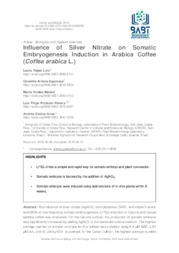Influence of Silver Nitrate on Somatic Embryogenesis Induction in Arabica Coffee (Coffea arabica L.).
Influence of Silver Nitrate on Somatic Embryogenesis Induction in Arabica Coffee (Coffea arabica L.).
Autoria: ROJAS-LORZ, L.; ARRIETA-ESPINOZA, G.; VALDEZ-MELARA, M.; PEREIRA, L. F. P.; GATICA-ARIAS, A.
Resumo: Plant somatic embryogenesis (SE) has been defined as the formation of embryos from a single or group of haploid or somatic cells [1, 2]. Low frequency (LFSE) and high frequency somatic embryogenesis (HFSE) have been described. In the first type, somatic embryos are induced directly from pro-embryogenic cells of explants, while in the second, they originate from embryogenic callus [1]. It has been suggested that in LFSE the origin of somatic embryos is unicellular, whereas in HFSE has been described as unicellular or multicellular [3]. SE is a powerful biotechnological tool used to propagate elite plants or to conserve important genotypes [4]. Moreover, SE offers an efficient in vitro regeneration approach as a fundamental step in plant genetic improvement for studying basic aspects of ontogenesis of somatic embryos [5]. In Coffea spp., the first studies of SE have been reported at the beginning of 1970 [6]. Since then, a large quantity of LFSE and HFSE protocols have been optimized demonstrating that coffee is not a recalcitrant species for SE [4]. In the LFSE the somatic embryos are obtained faster (approximately 70 days) using only one medium meanwhile in HFSE several media are used and somatic embryo formation takes 9-10 months [4]. Although, in LFSE small number of somatic embryos are obtained (around 10 per explant) compared to hundreds of somatic embryos obtained per gram of embryogenic calli [4], the unicellular origin of somatic embryos in LFSE represents an advantage for the chemical and physical mutagenesis, genetic transformation and genetic editing, since prevents or reduces the appearance of chimeras [7]. In C. arabica and C. canephora many factors (such as genotype, explant type, the physiological state, age and growth conditions of the donor plants, the season of collection, nutrient composition of the medium, the volume of dissolved CO2 or O2 in the culture flask, and plant growth regulators) that affect LFSE induction have been studied [3, 8, 9, 10, 11, 12, 13]. However, few studies reported the effect of silver nitrate on LFSE using leaf explants of C. arabica L. and to the best of our knowledge it has not been analyzed using Caturra and Catuaí, which are two economic important producer cultivars in Costa Rica. Since SE is genotype dependent, the culture medium need to be modified for the different genotypes [7].Therefore, the objective of this study was to determine the influence of the benzyladenine (BAP), indole-3-acetic acid (IAA), and silver nitrate (AgNO3) on low frequency somatic embryogenesis using leaf explants of Coffea arabica L. cultivars Caturra and Catuaí.
Ano de publicação: 2019
Tipo de publicação: Artigo de periódico
Unidade: Embrapa Café
Palavras-chave: Plant growth regulators, Silver nitrate, Somatic embryos, Tissue culture
Observações
1 - Por padrão são exibidas publicações dos últimos 20 anos. Para encontrar publicações mais antigas, configure o filtro ano de publicação, colocando o ano a partir do qual você deseja encontrar publicações. O filtro está na coluna da esquerda na busca acima.
2 - Para ler algumas publicações da Embrapa (apenas as que estão em formato ePub), é necessário ter, no celular ou computador, um desses softwares gratuitos. Sistemas Android: Google Play Livros; IOS: iBooks; Windows e Linux: software Calibre.
Acesse outras publicações
Acesse a Base de Dados da Pesquisa Agropecuária (BDPA) para consultar o acervo completo das bibliotecas da Embrapa.

